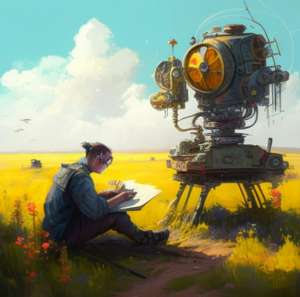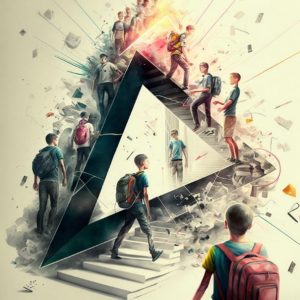Generative AI – The new challenge in and for Education
Publication date: February 23, 2023
By Marco Neves, computer science teacher and CEO of the Internet Ideas Company
What is AI Generative
Generative AI refers to a type of artificial intelligence that can generate new data, such as text, images, or music, that takes existing data to produce new data through a prompt given by the user.
This is achieved through deep learning models, such as Generative Adversarial Networks (GANs) or Variational Autoencoders (VAEs). Generative AI can be used for many applications, such as image and video synthesis, natural language generation, and data augmentation. Recent Generative AI models utilize transformer architectures as the backbone for their models. Transformers are a type of neural network architecture that was introduced in the paper “Attention Is All You Need” by Vaswani et al. in 2017. They are particularly well-suited for tasks that involve sequential data, such as natural language processing (NLP) and speech recognition.
In the field of Generative AI, it is also important to mention Large Language Models and Large Diffusion Models once they are the base for tools, among others, such as chatGPT and Mid Journey.
Learn more about Generative AI with this short video.
But…. how it is possible? A short intro on LLMs and LDMs
Large Language Models (LLMs) are neural network-based models that are trained on large amounts of text data to generate human-like text. These models are trained to predict the next word in a sentence, given the previous words. They can generate text that is coherent, fluent, and often semantically correct. Examples of LLMs include GPT-2, GPT-3, and BERT.

LLMs are typically pre-trained on large amounts of text data and fine-tuned on specific tasks such as question answering, language translation, and text summarization. The pre-training process allows these models to learn the language’s underlying structure and generalize to new tasks with minimal fine-tuning.
Large Diffusion Models (LDMs) are another type of generative model. These models make it incredibly easy to generate high-quality images in various styles using just a few words. Diffusion models are Machine Learning (ML) systems that were initially designed to remove noise from images. Recently, diffusion models have overtaken Generative Adversarial Networks (GANs) to become state-of-the-art image generators.
Explore more about Generative AI and LLMs and LDMs here .
But everybody has been talking about something, what it is? chatGPT?
ChatGPT, short for “Chat Generative Pre-trained Transformer,” is a variant of the GPT-3 model that has been fine-tuned for conversational language understanding and generation. The model is trained on a large dataset of conversational text, which allows it to understand and generate text that is like human conversation.

There are several reasons why ChatGPT is generating a lot of enthusiasm in the AI community:
- Its high-quality text generation: ChatGPT can generate text that is coherent, fluent, and semantically correct, which makes it suitable for a wide range of conversational applications such as chatbots, virtual assistants, and language translation.
- Its ability to understand the context: ChatGPT is able to understand the context of a conversation and generate responses that are appropriate for the given context, which makes it suitable for more complex conversational applications such as customer service and personal assistants.
- Its ability to be fine-tuned: ChatGPT is a pre-trained model that can be fine-tuned for specific tasks, which makes it more flexible and adaptable for different use cases, and it can be fine-tuned with a small amount of data.
- Its ability to generate human-like responses: ChatGPT is able to generate text that is similar to human conversation, which makes it more engaging and natural for users.
- Its size and computational power: ChatGPT is one of the largest pre-trained models, with 175 billion parameters, and it requires powerful computational resources to train and run.
And what about the field of Education?
ChatGPT and other large language models like it can be a valuable tools for education, but there are also challenges that schools, teachers, and students should be aware of
- Bias: ChatGPT and other language models are trained on a large dataset of text data, which can reflect the biases present in the data. This can result in the model generating text that is biased or offensive. Teachers and students should be aware of this and should be taught to critically evaluate the text generated by the model.
- Lack of understanding: ChatGPT is a complex model, and it can be challenging for teachers and students to understand how to use it effectively. Teachers and students should be provided with appropriate resources and training to help them understand and use the model effectively.
In summary, ChatGPT and other large language models like it have the potential to be valuable tools for education, but it’s important to be aware of the challenges and to take appropriate measures to address them.

… more ideas and examples on how to use chatGPT?
Examples of how a teacher can use chatGPT to enhance their pedagogical practices.
- Essay Writing Assistance: A teacher can use ChatGPT to help students with their writing assignments by providing suggestions for sentence structure, grammar, and vocabulary.
- Summarizing Texts: A teacher can use ChatGPT to help students summarize long texts by providing a condensed version of the main ideas.
- Generating Discussion Questions: A teacher can use ChatGPT to generate thought-provoking discussion questions based on a given text or topic.
- Providing Additional Reading Material: A teacher can use ChatGPT to generate a list of related texts or articles for students to read and expand their understanding of a given topic.
- Improving Vocabulary: A teacher can use ChatGPT to help students improve their vocabulary by providing definitions and synonyms of words used in a text.
- Language Translation: A teacher can use ChatGPT to help students understand texts written in a foreign language by providing translations.
ChatGPT can help a teacher create educational resources in several ways:
- Generating Lesson Plans: A teacher can use ChatGPT to generate lesson plans based on a given text or topic. The plans can include activities, discussion questions, and assessments.
- Creating Flashcards: A teacher can use ChatGPT to generate flashcards with vocabulary words, definitions, and example sentences to help students study and review.
- Generating Worksheets: A teacher can use ChatGPT to generate worksheets with questions, exercises, and activities to help students practice and apply what they have learned.
- Creating Quizzes and Tests: A teacher can use ChatGPT to generate quizzes and tests that assess student comprehension and retention of a given text or topic.
- Generating Study Guides: A teacher can use ChatGPT to generate study guides that summarize key concepts and ideas from a text or topic, and provide questions for review and reflection.
- Generating Content Presentations: A teacher can use ChatGPT to generate interactive presentations that can be used to explain a topic in a more interactive way.
Regarding Presentations, chatGPT will not create the slide, since it is a text-based assisted AI tool but will give you the content structure to be added on the slide as well the description of the image. Regarding the image, we can use a generative AI tool to generate the image, which could be for example Midjourney.com
An interesting approach for collaborative work is challenging students to create books with images. They can use ChatGPT yo help them with text creation and MidJourney or Dalle2 to create the images, then they must put everything together to produce the final product.
Final considerations
Even though we can recognize that chatGPT is just the beginning of a transformation regarding the potential for these tools assisted by AI, is important to mention that should be aware of some considerations before the integration of AI-assisted tools in Education, more specifically LLM (e.g. chat GPT), such as:
– Students must be properly informed of the limitations of these tools and always have a very critical, thoughtful, and demanding attitude towards the outputs obtained.
– Students must learn to know how to interact with these tools, chatGPT is the first with this potential but it is only a starting shot in this field, and both teachers and students are in a learning phase. Banning is the most harmful attitude you can have towards students.
– Using these tools in certain school years and according to certain principles and objectives may not be beneficial to students’ learning.
– The importance of creating prompts is not a simple process, but a complex one, and it requires students to have background/experience in terms of knowledge about the subject they will interact with these tools, it is critical that teachers work on this skill with students.
– Students must realize that meaningless questions will inevitably lead to meaningless answers and suggestions, even if the system has some safeguards for control and protection.
– A system like chatGPT, which is called a ‘Large Language Model’, is geared towards interaction in terms of discussion and suggestion of textual content not, for example, a system for solving mathematical challenges. If we do not ask a calculator to write a reflection, the chatGPT should not be geared toward performing mathematical calculations.
– These tools, trained on huge amounts of data from numerous scientific and other fields, should not be expected to be experts in any specific area, just as no human is an expert in all areas of knowledge. It should be seen in the field of learning as a support tool.
Reflections for teachers in the time of Generative AI
– “chatGPT should not be banned from schools but taught. Schools should be given the tools to understand and use these technologies. The debate that is developing in these weeks is unreal” Luciano Floridi (2023)

– In Education, the inherited model was that of a “factory”, but the model our students need today is that of a “creativity and design hub”.
– If Generative AI is more and more a working tool and increasingly used, what sense does it make to ban it from schools? Isn’t it one of the basic pillars of Education to prepare students for the future? If yes what leads us to ban Generative AI in schools?


